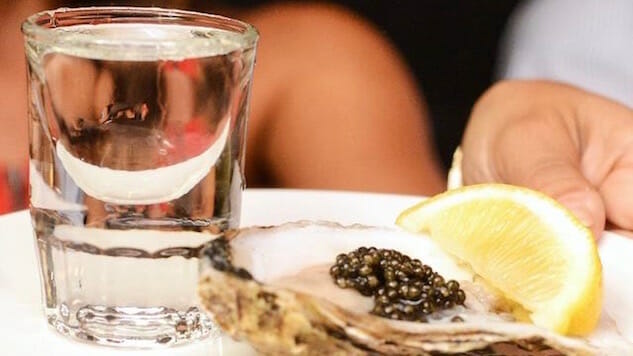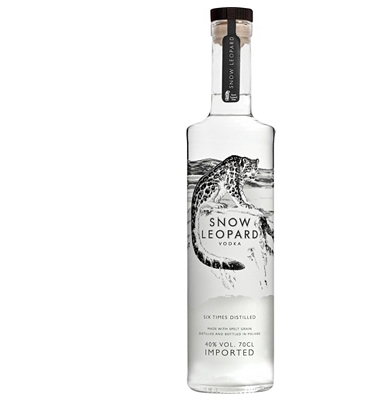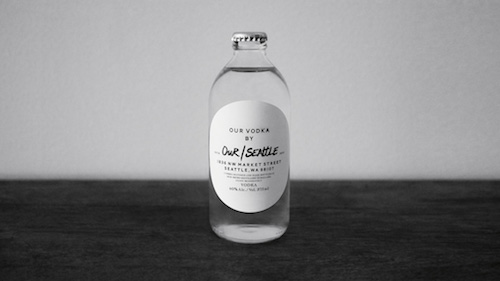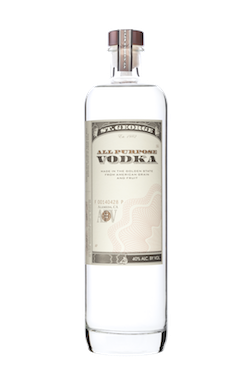
How do you get people who only consume, think about, and obsess over brown spirits to even consider vodka? That’s a question I posed to several different vodka representatives while researching this article, and a very sensible response arrived from Brent Lamberti, global brand ambassador for elit by Stolichnaya, one of the brand’s premium expressions. “Technically, vodka is un-aged whiskey,” he told me. “Both spirits are made from grain. Where whiskey differs is in the aging process, whereas most vodka producers utilize some method of filtration. Straight vodka is what I like to call the ‘naked’ spirit. There is nowhere for bad flavors to hide.”
Our/Vodka’s cofounder and CEO, Åsa Caap, had her own cheerfully pithy take on this burning question (happy face included): “The U.S. is still one of the world’s largest vodka markets, so even if they talk about whiskey they seem to drink vodka. :)”
Both spirits experts are absolutely right, but still… I’m not a vodka drinker, and I never really have been. If I’m drinking a martini, it’s always going to be made with gin. And 99% of the time I’m going to be drinking whiskey anyway. The only times I have ever really tried to drink vodka were in situations where there appeared to be no alternative – visits to Russian and Ukrainian restaurants and banyas in Brooklyn’s Brighton Beach neighborhood, and visiting my father-in-law in Moscow. In the banyas because, you know, when half-naked, burly Russians and Ukrainians drink vodka, shot after shot, washing down borscht and potatoes and unidentifiable pickled vegetables in a steamy setting, you kind of have to follow suit. And in Moscow, because that’s just what they do. A lot.
So there’s got to be more to vodka than sugary vanilla-flavored club drinks, Spike Lee-branded bottles, and Cosmopolitans, right? The answer is yes; vodka brands, from the giants of the industry to small upstarts, take this clear, centuries-old spirit very seriously, experimenting with different grains and methods of filtration to give their particular vodka a unique and complex character that they claim gives whiskey a run for its money.
Here are five vodkas that could win over whiskey drinkers.
elit

The aforementioned elit by Stolichnaya comes in a sort of ridiculous looking bottle – a clear, slender tube topped with a tilted black band, and emblazoned with a Hunger Games-style flaming triangle. But this 80 proof, self-proclaimed “ultra luxury” vodka is actually quite enjoyable. The nose is slightly alcoholic and grainy, but the palate is smooth and has a lovely, long, sweet finish, nary a hint of the harsh medicinal burn the unschooled might associate with most vodka. The grains that make up elit consist of a blend of winter wheat, spring wheat, and rye, all from the Raduga farm in the Tambov region of Russia. All Stoli vodka is distilled three times and filtered four times, but elit gets a fifth freeze filtration (-18 degrees Celsius, passed through an ionized carbon filter), inspired by the methods of the Russian tsars. If all this sounds too technical, that’s understandable, but the gist is that Stoli is removing as many impurities as possible, and this final freeze turns the vodka into a viscous fluid, making that process easier. Lamberti recommends drinking elit neat at room temperature to really taste it, but pairing it chilled with caviar is his preferred method of imbibing (I’ll get back to you about that when I write a caviar story).
Snow Leopard

Stephen Sparrow set about creating Snow Leopard after traveling in the Himalayas in 2005 and becoming aware of the existence of the endangered animal for which this spirit is named. A portion of the vodka’s profits are donated to “vital conservation efforts, including research and livestock insurance and vaccination, as well as education and economic training for the herders who share the snow leopard’s habitat in the rugged mountains of Central Asia,” according to Sparrow. A noble cause, indeed, but how does the vodka taste, and how does its spelt grain base differentiate it from other vodkas? Spelt is an ancient grain, essentially hulled wheat, which is supposed to be a good source of fiber and dietary minerals. Sparrow goes so far as to compare Snow Leopard to whiskey, claiming that it rivals the brown spirit in complexity. “The spelt grain… brings out a nutty, buttery flavor, which added to its super smooth finish provides a superb drinking experience for the consumer,” he says. The vodka is distilled six times in a continuous column still. Spelt is more expensive to use in vodka than other grains, but Sparrow says the outer hull protects it from pollutants and helps it retain nutrients and flavor. I have to agree with his contention that Snow Leopard can stand up to whiskey – the palate is creamy and peppery, far from the bland rubbing alcohol that vodka ignoramuses like myself might expect. Sparrow recommends drinking Snow Leopard in a classic martini.
Our/Vodka

Åsa Caap hit upon a great idea for Our/Vodka. The Swedish businesswoman essentially started a vodka franchise, supplying basic equipment to entrepreneurs in various cities around the world. Right now Our/Vodka has taken hold in London, Detroit, Seattle, Berlin, Amsterdam, Houston, with other cities in the works. “The deal is that [the local distilleries] run the local business for us,” says Caap. “So they invest their time and we invest the money. Then, when we are profitable, we share 20% profit with them. Since the product is then made in the micro-distillery that we build in each city, we also source the ingredients as locally as possible.” That means wheat for Berlin, Amsterdam, and London; corn for Detroit; potato for Seattle; and sugarcane for Miami. Presumably that means that each vodka differs slightly in taste. I tasted the Detroit and Seattle versions side by side and couldn’t discern much of a difference, but they were both pleasantly fruity and very smooth. Our/Vodka comes in small 375 ml bottles with bottle caps that you remove and then replace with a plastic cap. However, both of my plastic caps cracked in exactly the same place, which makes me wonder if this quirky trait is the best method. Over all, though, it’s a small detail, as Our/Vodka is making its mark as an innovative spirits brand focused on quality and local sourcing.
St. George All Purpose Vodka

Photo credit: Jason Tinacci
I’ve written about California’s St. George Spirits time and time again – this small, craft operation continually produces an array of truly remarkable spirits, including single malt whiskey, apple brandy, gin, and yes, vodka. The aptly named All Purpose Vodka was one of the most unique that I tried, most likely due to the fact that it’s distilled from Bartlett pears. This gives it an intensely fruity and floral flavor, without actually tasting like pear. It’s not all pear in the mash bill, though – the distillery blends its pear brandy with a non-GMO base spirit made from corn, and then filters it to remove impurities. There’s no backstory about ancient grains or Russian history here, but the resulting spirit is lovely.
Blue Ice

Finally, Idaho’s Blue Ice Vodka, an incredibly smooth drinking spirit, is made with – you guessed it, Idaho potatoes. Specifically, Idaho Russet Burbank potatoes. Also, water that flows down from the Grand Tetons. But all of that wouldn’t count for much if the liquid didn’t taste good, and in this case the liquid tastes pretty good. Also, for all the Breaking Bad fans out there who are trying to recapture the thrill with “Better Call Saul” and only partially succeeding, Blue Ice has a Heisenberg line of vodka. This is a limited edition bottling with Walter White’s shadowy visage peering out from the front, some choice quotes on the label, and a stimulating methamphetamine connotation to battle your inebriation.
So can vodka find a foothold with the fiercely opinionated, dedicated, bloviating whiskey aficionados of the world? The answer seems to be… maybe. Depending on the vodka. Depending on the grains from which it’s made. Depending on the method with which it’s distilled. But these are all reasons to embrace vodka, because just like whiskey there is so much variety in this category of spirits and as many reasons to drink it. So while you might not find me replacing my pre-dinner whiskey with a vodka on the rocks any time soon, I’ll certainly be pulling my vodka bottles from the back of the liquor cabinet for serious consideration.